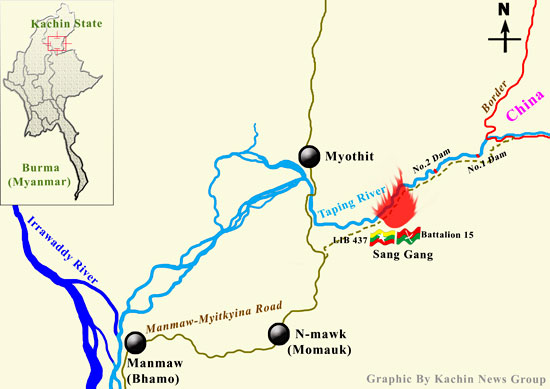The gun battle between the Burmese Army and the Kachin Independence Army (KIA) in Kachin State, Northern Burma, has temporarily stopped after exchange of live and dead captives, KIA officials said.
In the exchange, the dead body of a Corporal KIA civilian fighter was exchanged for six Burmese Army captives, including two officers, on Thursday, June 9 at 6 p.m. at the frontline, according to sources at the frontline.
 The Corporal KIA fighter was killed by different forms of torture by Burmese troops after he was arrested at the KIA Sang Gang Post Wednesday morning, the sources added.
The Corporal KIA fighter was killed by different forms of torture by Burmese troops after he was arrested at the KIA Sang Gang Post Wednesday morning, the sources added.
Two Burmese officers and one soldier were captured in Sang Gang by KIA Battalion 15 on Wednesday, June 8, and three more Burmese soldiers were captured in the Sang Gang fighting, said sources from KIA Battalion 15.
Two Burmese soldiers were killed and more than 10 were injured in the fighting. Two KIA soldiers were injured by Burmese mortar rounds, sources said.
The fighting took place at the Sang Gang Post in N’mawk (Momauk) Township, in Manmaw (Bhamo) District. It started at 7 a.m. in the morning and ended at 1 p.m., according to witnesses.
More than three Burmese Battalions with about 500 troops were involved in the fighting at Sang Gang with KIA Battalion 15, in N’mawk Township. The identified Burmese troops were from the N’mawk-based Light Infantry Battalion No. 437, Manmaw-based Infantry Battalion No. 237 and Dawhpumyang-based Infantry Battalion No. 142, according to KIA officials.
Most of the Burmese troops were withdrawn from the area of the fighting after the exchange of captives, said sources from the battle zone.
No more fighting has taken place at the KIA bases in Kachin State and Northern Shan State after yesterday morning’s fighting.
Meanwhile, the leaders of the Kachin Independence Organization (KIO), the political wing of KIA, are trying to initiate a political dialogue on the two parties’ problems with President Thein Sein’s central Burmese government.



